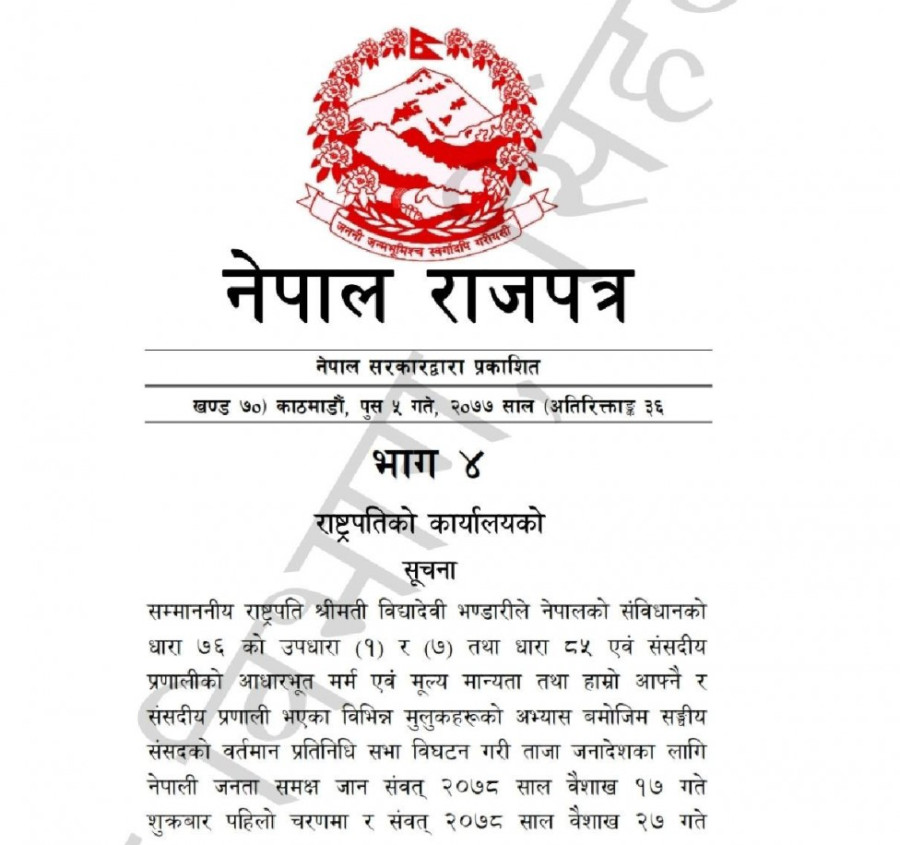National
A scrambling Oli government produces gazette before court, but it’s backdated
Hiding information and distorting it have been the hallmark of the Oli government and not publishing the House dissolution notice is a major procedural lapse, experts say.
Tika R Pradhan
Hide information, distort it, and confuse and mislead all. That’s how the KP Sharma Oli administration seems to have been functioning.
After questions were raised during Thursday’s hearing about why the government had not published the notice regarding the government’s December 20 decision to dissolve the House, Attorney General Agni Kharel on Friday presented before the court the copy of the gazette with the notice.
The Department of Printing, which until Thursday night had not uploaded the Nepal Gazette with the notice, had it up on its website on Friday morning.
December 20, however, has been mentioned as the publication date of the notice in the Nepal Gazette.
At least two officials at the Department of Printing confirmed that the gazette was printed on Thursday evening and was uploaded on its website on Friday morning.
“The gazette was printed yesterday at around 7:30pm,” said Bimala Koirala, assistant spokesperson for the Department of Printing. “That was uploaded on our website on Friday morning.”
Many were quick to point that the Oli government had committed a forgery, by publishing a backdated notice after it was caught on the backfoot.
“The government has been involved in such activities and what has happened now is tantamount to forging documents,” said Shalikram Sapkota, an advocate who is pleading on behalf of the petitioners challenging Oli’s House dissolution move. “The government took the decision to dissolve the House on December 20, but a notice in this regard has been published in Nepal Gazette almost a month later with a backdate. This is out and out a wrong practice.”
Nepal Gazette—called Nepal Rajpatra in Nepali—is the authentic publication of the Nepal government.
According to the website of the Department of Printing, which is under the Ministry of Communication and Information Technology, the gazette, published regularly since 1951, carries all important government decisions to give them legal status and inform the people about the decisions.
Constitution or declarations at par with constitution; Acts, ordinances stamped by the President after parliamentary endorsement; regulations endorsed by the Cabinet and orders issued by the government; appointments and notices issued as per the constitution; notices as per the Acts, rules and orders or the decision of government which are decided to be published in the gazette and treaties and agreements of which Nepal is party must be published in the Nepal Gazette.
Former chief secretary Bimal Koirala said government decisions do not get the legal status until they are published in the gazette.
“Decisions must be published in the gazette, it’s a mandatory process,” Koirala told the Post. “But sometimes governments tend not to do so.”
As many as 13 writ petitions have been filed against Oli’s House dissolution move at the Supreme Court. Chief Justice Cholendra Shumsher Rana-led Constitutional Bench has been hearing the writ petitions to test the constitutionality of Oli’s move.
Lawyers have been arguing that Nepal’s 2015 constitution has made a departure, not allowing a majority prime minister to dissolve the House, and such provisions were deliberate attempts at ensuring political stability.
According to the drafters of the constitution, it was made difficult for a prime minister to dissolve the House because in the past a prime minister was given an inherent power to dissolve the Parliament and call snap polls.
At least four prime ministers who worked under the 1990 constitution had attempted House dissolution.
Despite the current constitution not allowing Oli, a majority prime minister, to dissolve the House, he did so on December 20.
The Oli government had run into controversy a few days ago also for taking a document back from the Supreme Court and not returning it on time despite committing to doing so. Many believe the original document that the government had furnished to the court had not cited articles based on which it had recommended the House dissolution.
However, the copy of the letter, signed by Prime Minister Oli, that later surfaced in the media did have articles cited. The controversy had arisen because another letter, a copy of which also had made it to public domain, signed by Chief Secretary Shankar Das Bairagi had not cited constitutional articles to recommend House dissolution.
Since the Oli government’s intent has come into question, legal experts say there are ample grounds to suspect foul play when it comes to not publishing the notice regarding House dissolution in Nepal Gazette.
Advocates Tikaram Bhattarai and Om Prakash Aryal, during Thursday’s hearing, had questioned the bench that the House dissolution decision was not published in Nepal Gazette.
Anil Kumar Sinha, one of the justices on the five-member Constitutional Bench, then asked the defendants if it was true that the December 20 House dissolution decision was not published in Nepal Gazette.
According to Aryal, unless the decision was published in the gazette, it cannot come into force and implementing a decision without publishing it in the gazette is unlawful.
“And since this decision of the government, which has dissolved the lawmaking body, is quite important, it should have been published in Nepal Gazette without fail,” Aryal told the Post.
The House dissolution move has courted so much controversy that legal experts have been demanding that the bench look to legislative intent while deciphering the constitutional provisions that have been cited by Oli and the President. Lawyers have also demanded that the bench seek transcripts, records and committee notes of the constitution drafting process.
Subas Nembang, who chaired the Constituent Assembly that gave the constitution in 2015, has been heard saying in video clips that the current constitution does not allow a prime minister to dissolve the House.
Oli and his lawyers, however, argue that in a parliamentary system, it’s the prime minister’s prerogative to dissolve the House.
Even Chief Justice Rana during the ongoing hearing has asked the petitioners and those arguing on their behalf multiple times why a majority prime minister cannot say he does not want to govern and he wants to go for a fresh mandate.
Harihar Dahal, a senior advocate, said that not publishing such an important decision in Nepal Gazette is a serious matter, as the practice in democracies worldwide is that government decisions get the legal status through their publication in respective gazettes.
“It’s now up to the court how it views the issue,” Dahal told the Post.
Advocate Aryal, who first inquired the bench on the whereabouts of the gazette, said the goings on show how Oli has been treating all the state organs and agencies as subservient to him.
“Oli has been displaying his totalitarian impulses for long and he is in a bid to have control over the state,” said Aryal. “He has no regard for the rule of law; he treats law as a means to fulfil his interest.”
Advocate Tikaram Bhattarai, who is pleading on behalf of the petitioners, said the Oli government has made one mistake after another and is now involved in all kinds of shenanigans to cover them up.
“Publishing the notice about House dissolution in the gazette after an uproar does not make sense,” said Bhattarai.“By publishing it with a backdate, the government has forged the gazette. But what can one expect from Oli who does not believe in process and procedures?”
While addressing the upper house on January 10, Oli had said people have nothing to do with processes and procedures as they can neither be worn nor eaten.
Koirala, the former chief secretary, said there was a clear procedural lapse as such a major decision like dissolving the House was not published in Nepal Gazette.
“Publishing the notice with the backdate after questions were asked is nothing but the executive’s high-handedness; it’s like those in power are trying to show they can do anything,” said Koirala. “It’s up to the court how it takes up this major lapse.”
Attorney General Kharel said he is not the authority to print the gazette.
“I just produced the necessary document before the court,” Kharel told the Post.




 4.91°C Kathmandu
4.91°C Kathmandu







%20(1).jpg&w=300&height=200)






